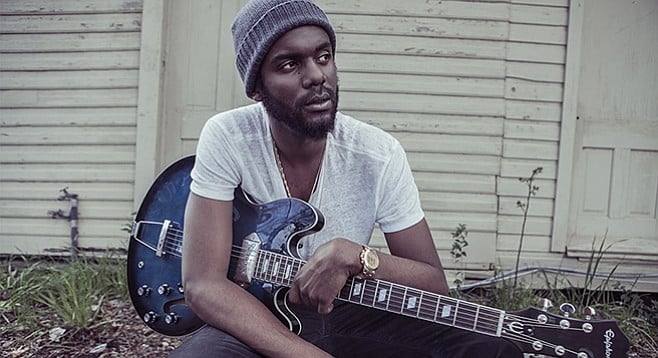 Facebook
Facebook
 X
X
 Instagram
Instagram
 TikTok
TikTok
 Youtube
Youtube

Although you wouldn’t know it by the way he plays the blues, Gary Clark Jr. calls Michael Jackson’s Bad tour one of his earliest musical influences, perhaps the first big push that had him playing guitar by the time he was 11 or so. Eventually, Clark would record a Jackson 5 tune for Sheryl Crow, but otherwise, he lists both the church and the worldly music scene in Austin, where he grew up, as his training ground. Clark says he gained much from jam sessions at venues such as Antone’s, a nightclub where true blues men like Pinetop Perkins and Hubert Sumlin and Jimmie Vaughan let the teen guitar player sit in.
Clark’s been on the big stages for only half a dozen years, and in that time he’s been a curiosity to the truer fans of the art. He is good for that thousand-yard blues-man stare, and his voice carries so much discomfort it almost hurts to listen to. But his own guitar is borderline sloppy psychedelic, and he fronts the least bluesy of blues bands I’ve ever heard. The rhythm section is solid rock, and drummer Johnny Radelat is a human jackhammer. Some say Gary Clark Jr.’s the future of the blues; others call him the death of it.
Either way, Clark’s topped the blues charts, accelerated from show opener to headliner, and has been anointed by pop-music royalty — Alicia Keys, Eric Clapton, the Stones (at Petco Park in 2015, Clark was their show-stealing support act), Dave Matthews, Kirk Hammett, and more. Touring now in support of his second full-length album, The Story of Sonny Boy Slim (released last year), at the core of the thing is a fictional story inspired by his own childhood and by the plot line of Honeydripper, a film in which Clark played a character named Sonny who transforms the blues into...rock and roll. Given the opportunity, life will imitate art every time.


Although you wouldn’t know it by the way he plays the blues, Gary Clark Jr. calls Michael Jackson’s Bad tour one of his earliest musical influences, perhaps the first big push that had him playing guitar by the time he was 11 or so. Eventually, Clark would record a Jackson 5 tune for Sheryl Crow, but otherwise, he lists both the church and the worldly music scene in Austin, where he grew up, as his training ground. Clark says he gained much from jam sessions at venues such as Antone’s, a nightclub where true blues men like Pinetop Perkins and Hubert Sumlin and Jimmie Vaughan let the teen guitar player sit in.
Clark’s been on the big stages for only half a dozen years, and in that time he’s been a curiosity to the truer fans of the art. He is good for that thousand-yard blues-man stare, and his voice carries so much discomfort it almost hurts to listen to. But his own guitar is borderline sloppy psychedelic, and he fronts the least bluesy of blues bands I’ve ever heard. The rhythm section is solid rock, and drummer Johnny Radelat is a human jackhammer. Some say Gary Clark Jr.’s the future of the blues; others call him the death of it.
Either way, Clark’s topped the blues charts, accelerated from show opener to headliner, and has been anointed by pop-music royalty — Alicia Keys, Eric Clapton, the Stones (at Petco Park in 2015, Clark was their show-stealing support act), Dave Matthews, Kirk Hammett, and more. Touring now in support of his second full-length album, The Story of Sonny Boy Slim (released last year), at the core of the thing is a fictional story inspired by his own childhood and by the plot line of Honeydripper, a film in which Clark played a character named Sonny who transforms the blues into...rock and roll. Given the opportunity, life will imitate art every time.
Comments